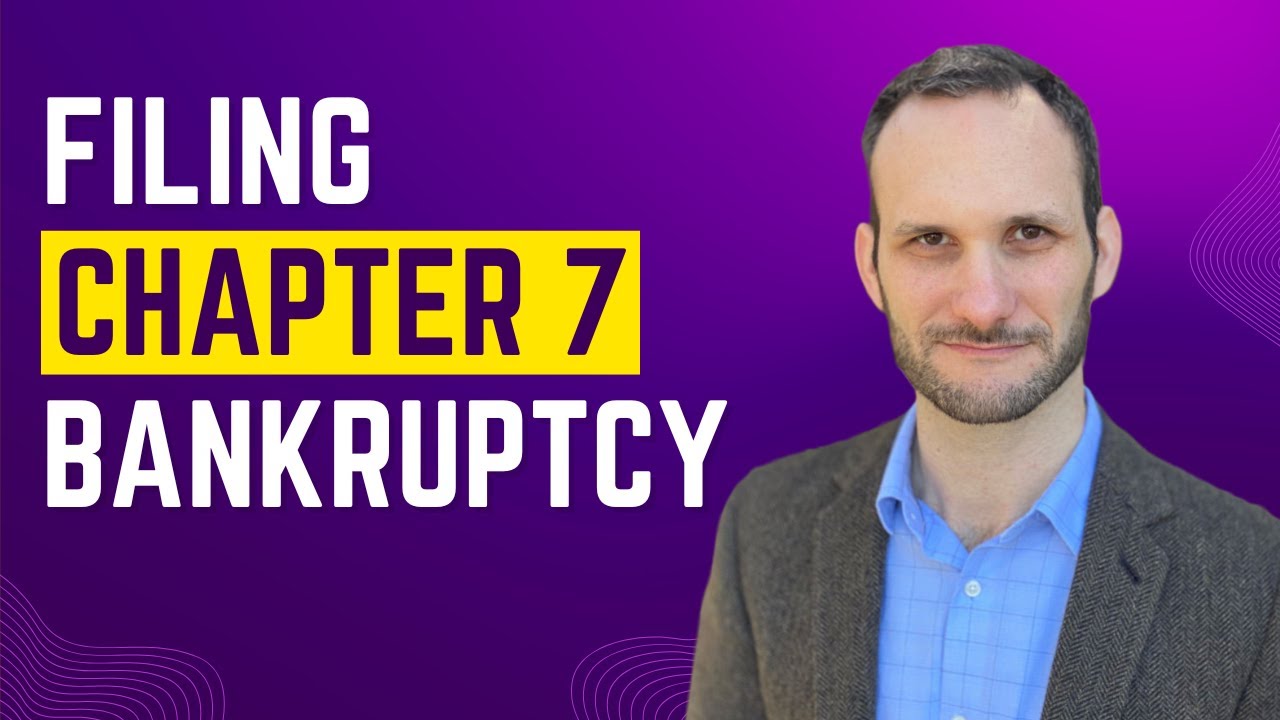Chapter 7 Bankruptcy in Florida
Filing Chapter 7 Bankruptcy in Florida
Chapter 7 Bankruptcy is the legal procedure where the debtor’s unsecured debt is discharged after the debtor’s non-exempt assets have been liquidated. To file a Chapter 7 bankruptcy in Florida, a person must be a permanent Florida resident or own property in the state. Florida has three bankruptcy districts (Southern District, Middle District, and Northern District), and each of Florida’s counties is assigned to one of the three bankruptcy districts. People must file bankruptcy in the district and local division where they reside.
Florida Bankruptcy Exemptions
Most people who file Chapter 7 bankruptcy in Florida are eligible to claim Florida bankruptcy exemptions.
In Florida bankruptcy, exemptions that apply are determined by the state in which the debtor has been domiciled for the 730 days (two years) immediately preceding the filing date.
Some bankruptcy debtors who are Florida residents when they file for Chapter 7 bankruptcy are not entitled to Florida exemptions because they have not lived in Florida during the preceding two-year period. Those debtors must claim bankruptcy exemptions allowed by the state in which they were domiciled for 180 days immediately preceding the two year period, or the state in which they were domiciled for the longer portion of such 180-day period.
In other words, a person filing bankruptcy in Florida today is eligible for the property exemptions he could have claimed if he had filed two years ago.
If this person was a Florida resident two years ago he claims Florida exemptions today; if two years ago the debtor resided in a different state then they are entitled to the exemptions of the state of their prior residence (or federal exemptions if that state has residency requirements for use of its exemptions).
We help protect what you’ve earned.
Jon Alper and Gideon Alper are nationally recognized experts in asset protection planning and implementation. In over 30 years, we have advised thousands of clients about how to protect their assets from judgment creditors.
We provide all services remotely by phone or Zoom.

Florida Homestead Exemption in Bankruptcy
The Florida Constitution exempts a Florida homestead of unlimited value from liens and execution. A debtor may protect unlimited amounts of money invested in a homestead property. A debtor may invest money into an exempt homestead even after being sued. These homestead rules apply in state court collection proceedings. Bankruptcy law has no effect upon Florida’s unlimited homestead exemption in state court proceedings.
But bankruptcy law is a federal law, and federal law may supersede state law in certain cases. The Florida homestead exemption is applied differently in a Chapter 7 bankruptcy than in Florida state court.
There are some value ceilings and purchase deadlines applicable to Florida’s homestead exemption in Chapter 7 bankruptcy. Under federal bankruptcy law, the debtor’s Florida homestead is exempt up to a value of approximately $160,000 (2020) unless the debtor occupied his current Florida homestead property and previous Florida homestead properties for a continuous 40-month period prior to filing bankruptcy. Joint bankruptcy debtors can protect approximately $320,000 of a jointly owned homestead. (2020) These numbers increase from time to time so debtors should get the current limits from their bankruptcy attorney. Chapter 7 bankruptcy debtors are entitled to an unlimited homestead exemption if they have occupied their Florida homestead for more than 40 months prior to filing.
Under Florida bankruptcy law, a debtor’s investment of non-exempt money in a homestead property within 10 years of filing bankruptcy may be challenged by the bankruptcy trustee if the transfer was intended to defraud creditors.
Florida Bankruptcy Means Test
The Florida bankruptcy means test is a complex formula to determine eligibility to file Chapter 7 bankruptcy. Debtors whose household income is under their state’s median income, and debtors whose debts are primarily business-related debts, are exempt from means test qualification. Bankruptcy debtors whose gross household income is above median income must pass the means test to file Chapter 7 bankruptcy.
Chapter 7 Bankruptcy Petition
A debtor initiates a Chapter 7 bankruptcy by filing a Petition with the bankruptcy court. The bankruptcy petition is a universal federal form that covers a substantial amount of financial information about the debtor and his family. Debtors must sign their Petition under oath.
The bankruptcy Petition requires the debtor to list all his unsecured debts separately from his secured debts. Unsecured debts include personal loans and credit cards issued by banks, such as Visa, MasterCard, American Express, or Discover, and other credit cards used to purchase consumable items. Vehicle leases, medical bills, and personal loans are also unsecured debts. Tax debt is also unsecured until the IRS issues a tax lien.
Secured debts include those debts where the creditor has a security interest in the debtor’s property to guarantee payment. Examples of secured debts include mortgages, car loans, and loans from finance companies (usually secured by household items). If a debtor has purchased goods using a store credit card, such as a card from Rooms to Go, Best Buy, etc., the store probably has a security interest in certain items purchased, which makes the store a secured creditor.
The debtor must indicate on the bankruptcy Petition whether they want to either reaffirm or redeem each secured debt or surrender the secured property to the secured creditor. A bankruptcy debtor is entitled to keep any secured property if the debtor continues to pay the loan for that property in a timely manner. If, however, the debtor elects to surrender secured property, the secured creditor may not thereafter recover any money from the debtor.
Chapter 7 Bankruptcy Procedures
The Chapter 7 bankruptcy debtor is required to list all liabilities, no matter how remote. The Petition should list any claim that anyone might have against the debtor even if the claim has not yet matured. For example, if the bankruptcy debtor is a co-debtor on a note, has personally guaranteed corporate or other debt, or is secondarily liable on a mortgage that has been assumed by a purchaser, the debt should be listed along with a brief explanation of the liability. Disputed debts and liabilities should also be listed. Also, if the debtor has ever had a home mortgage that was insured by a government agency (such as the VA), the Petition must list that agency as a contingent creditor. This should be done even when someone purchased the property and assumed the mortgage since they might default, and the VA could decide to pursue a claim against the debtor.
The first step in the Chapter 7 bankruptcy is the filing of the petition. The filing of a Chapter 7 bankruptcy creates a bankruptcy estate. The bankruptcy estate refers to all of the debtor’s non-exempt property that is subject to administration by a bankruptcy trustee. A trustee is randomly appointed by the Court immediately upon the filing of a Chapter 7 Petition. The Chapter 7 trustee is usually a private attorney or CPA. The trustee’s job in Chapter 7 bankruptcy is to gather all of the debtor’s non-exempt assets, sell those assets (to either the debtor or an outside party), and distribute the proceeds among the debtor’s scheduled unsecured creditors.
Exempt assets, such as the debtor’s homestead and IRA, are not part of the bankruptcy estate, and the trustee cannot interfere with exempt assets.
An automatic stay is imposed immediately upon the filing of a Chapter 7 bankruptcy. The stay prohibits creditors from pursuing legal action against the debtor and stops all creditor legal collection efforts. The bankruptcy attorney can file a Suggestion of Bankruptcy in ongoing civil lawsuits involving the debtor. The Suggestion of Bankruptcy suspends all such litigation. It is important for debtors to provide their attorney with a copy of any lawsuits filed against them so that the attorney may prepare a Suggestion of Bankruptcy.
In Chapter 7 bankruptcy cases, mortgage creditors typically file a Motion for Relief From Automatic Stay so that they may foreclose on secured property if the debtor does not make payments in a timely manner. The bankruptcy court will usually grant this motion. The creditor can take the bankruptcy debtor’s property only if the debtor does not pay secured loans in a timely manner, and only after the creditor forecloses its lien in state court.
Summary of Bankruptcy Steps
Overall, the process to file bankruptcy in Orlando includes the following steps:
- Prepare the bankruptcy petition. The petition includes all the information about your debts, your income, and your assets.
- Automatic Stay. Also called a “suggestion of bankruptcy,” the automatic stay stops all collection efforts against you during the bankruptcy process.
- Relief from Stay. Mortgage creditors and other unsecured creditors can seek relief from the stay to foreclose on their secured property.
- Assignment to a Chapter 7 Trustee. The bankruptcy case is assigned to an Orlando bankruptcy trustee. A meeting is held in a conference room with you, your bankruptcy attorney, and the trustee. The trustee will ask general questions about all of the information in your bankruptcy petition.
- Objection to Exemptions. The bankruptcy trustee can assert objections to any exemptions claimed in the bankruptcy petition.
- Adversary Claims. A trustee or a creditor can file an adversary claim if a creditor does not think a debt should be discharged or if a creditor thinks you have abused the bankruptcy process. This does not happen often.
- Bankruptcy Discharge. Any non-exempt assets will be sold by the bankruptcy trustee in a Chapter 7 case. Your dischargeable debts will then be discharged by the bankruptcy court. This means you would no longer owe the debt.
Filing bankruptcy is not as easy as simply filling out bankruptcy forms. There are some areas of bankruptcy law that are most frequently the subject of debtor questions. These areas include the means test, discharge of income tax liability through bankruptcy, attorney fees, how to avoid common bankruptcy mistakes, and other frequently asked questions.
Meeting the Bankruptcy Trustee
The bankruptcy court will schedule a meeting with an appointed Chapter 7 trustee. This meeting is called the creditors’ meeting or the 341 meeting. The meeting is held in a conference room, not a courtroom. Typically, this meeting will last ten to fifteen minutes.
A representative of the U.S. Trustee’s office (a different trustee) sometimes attends these meetings. The debtor and his bankruptcy attorney are required to attend the creditors meeting (if filing jointly, both spouses must attend). As a practical matter, very few, if any, unsecured creditors attend. The Chapter 7 bankruptcy trustee represents all creditors whether or not unsecured creditors attends the meeting of creditors.
The Chapter 7 bankruptcy trustee asks the debtor questions at the creditors meeting, but they will not interrogate, cross-examine, or threaten the debtor. The trustee may ask the debtor why they filed bankruptcy and ask questions about the debtor’s assets and sources of income. The trustee often asks about the debtors income and expenses to make sure the debtor qualifies for Chapter 7 bankruptcy and that the bankruptcy is not an abusive filing.
Creditors’ meetings are scheduled by the court based on the trustee’s schedule. Your bankruptcy attorney is not able to request a meeting date or time. If the debtor or their attorney is unable to attend the scheduled 341 meeting, the trustee usually schedules a “make-up” meeting approximately two weeks after the first date. If the debtor fails to attend the second meeting, the trustee may move to have the bankruptcy dismissed.
Objections to Debtor’s Bankruptcy Exemptions
The Chapter 7 bankruptcy trustee has 30 days after the conclusion of the creditors meeting to object to any exemption of property the debtor has claimed on the bankruptcy Petition.
If the trustee objects to a claimed exemption, the court will set a hearing at which time the debtor has the opportunity to support the exemption. Absent a trustee objection within 30 days after the filing date, all property the debtor claimed as exempt on the Petition, including homestead, is exempted in bankruptcy and is not part of the bankruptcy estate.
Reaffirmation Agreements
A Chapter 7 debtor must file, within 60 days of the 341 meeting, a reaffirmation agreement for all secured property, such as cars, the debtor wants to retain. If the debtor does not sign the reaffirmation agreement or redeem the property within 60 days, the automatic stay is lifted as to that property, and the creditor is permitted to repossess the property, even if the debtor’s payments are current.
A reaffirmation agreement states that the debtor agrees to remain personally liable to pay the debt after the bankruptcy is over. If the debtor does not sign a reaffirmation, the Chapter 7 bankruptcy will wipe out the debt, but the secured creditor can take the secured property.
The debtor’s bankruptcy attorney will usually co-sign a reaffirmation agreement if the attorney believes the debtor has sufficient disposable income to pay the secured debt after the bankruptcy is concluded. The attorney may choose not to sign a reaffirmation agreement if the debtor has negative disposable income or if the attorney believes the debtor’s reaffirmation of the liability would create an undue hardship.
If the bankruptcy attorney does not approve and co-sign a reaffirmation agreement, the Florida bankruptcy judge will review the reaffirmation agreement and either approve or deny the agreement, sometimes after an evidentiary hearing. The bankruptcy judge will deny reaffirmation if he believes that reaffirmation is not in the debtor’s best interest for a “fresh start.”
Even if the court refuses to approve a debtor’s reaffirmation, many creditors will let the bankruptcy debtor keep the secured property as long as payments are current.
Redemption
Redemption is how a debtor can keep their car in bankruptcy. Chapter 7 bankruptcy gives debtors a different option regarding loans secured by personal property. The debtor may “redeem” secured personal property such as furniture, computers, automobiles, or other property purchased on credit and secured by a lien in favor of the creditor.
Redemption means purchasing property from the secured creditor at its current fair market value. Redemption can be financially beneficial for the debtor when the property’s fair market value is less than the amount due under the loan.
Executory Contracts During Chapter 7
An executory contract is a legal term referring to a contractual agreement in which both parties are obligated to perform in consideration for a benefit (such as a car lease or a residential lease). Executory contracts do not include “at will” contracts such as an employment agreement or a personal service contract.
Chapter 7 bankruptcy permits the debtor, or the trustee, to assume or reject an executory contract. A debtor must decide if they want to remain bound by their executory contracts prior to the court’s issuance of a bankruptcy discharge which usually happens about 90 days after filing.
A car lease is an example of an executory contract. If the debtor rejects a car lease, they surrender the car to the leasing company and have no further personal liability. If the debtor wants to assume the lease, the debtor can keep the property if they make the lease payments. If the debtor subsequently defaults in lease payments, the leasing company can take back the car.
Assumption of an executory contract is not the same as a reaffirmation of the lease, so the leasing company may not sue the debtor for the balance of payments due under the lease following default.
Student Loans in Chapter 7 Bankruptcy
Student loans are not dischargeable in Chapter 7 bankruptcy unless the debtor can demonstrate that loan payments impose “undue hardship.” To eliminate a student loan under the “undue hardship exception,” the debtor must file a separate motion with the bankruptcy court and appear before the bankruptcy judge with evidence of hardship. As a practical matter, it is difficult for bankruptcy debtors to demonstrate undue hardship unless the debtor is physically unable to work.
Most bankruptcy courts use the Brunner test in determining hardship. Under this test, to discharge student loans in bankruptcy, the debtor must show:
- That the debtor cannot maintain, based on current income and expenses, a ‘minimal’ standard of living if forced to repay the loans.
- Additional circumstances exist indicating that this state of affairs is likely to persist for a significant portion of the repayment period of the student loans.
- That the debtor has made good faith efforts to repay the loans.
Adversary Claims and Objections
If a creditor believes its debt should not be discharged, it may file “an adversary” case during the bankruptcy proceeding. The most common ground for a creditor filing an adversary case is fraud.
Fraud in this context is not criminal. In this context, “fraud” means that the debtor abused his relationship with the creditor and bankruptcy process. Fraud supporting a creditors discharge objection could, for example, refer to a bankruptcy debtor who used a credit card to buy property or take cash advances prior to filing bankruptcy when the debtor was financially insolvent.
If a debtor incurred a debt when the debtor planned to file bankruptcy the creditor could have a basis to set aside a discharge of that debt for fraud during an adversary case.
Bankruptcy Discharge
The bankruptcy discharge is the legal process that wipes out a debtor’s legal liability to pay unsecured creditors. Creditors of debts that have been discharged in bankruptcy can never again try to collect debts the debtor had incurred prior to filing bankruptcy. A debtor may sue a creditor for damages and sanctions if the creditor attempts to collect a debt after the debtor’s bankruptcy discharge has been entered.
How Long Does It Take to Rebuild Credit After Chapter 7 Bankruptcy?
For most people, it will take anywhere from 1 to 2 years to build back credit. After that timeframe, most people can get a new loan, such as a home loan mortgage. Credit card applications will come even earlier.
Sign up for the latest information.
Get regular updates from our blog, where we discuss asset protection techniques and answer common questions.










